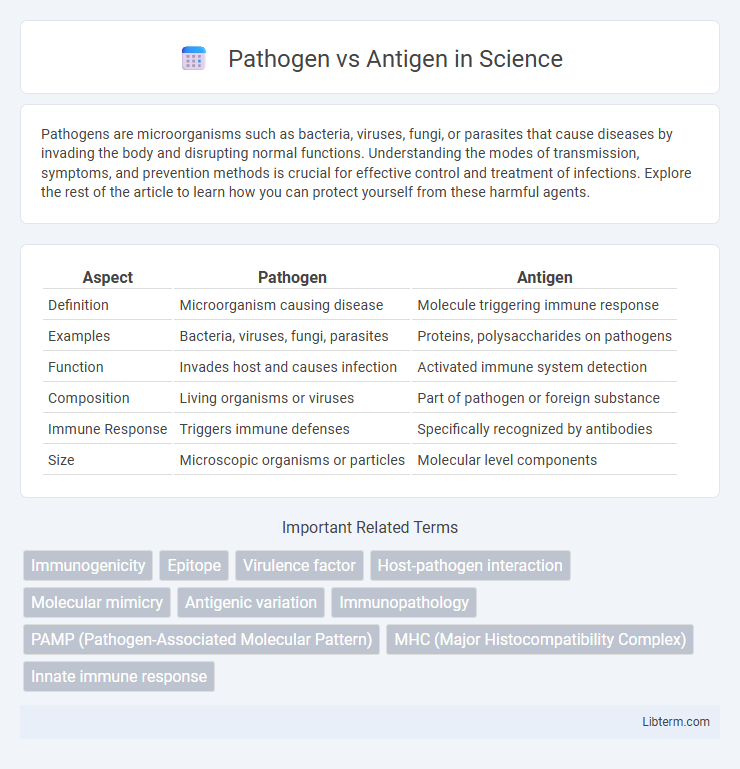Pathogens are microorganisms such as bacteria, viruses, fungi, or parasites that cause diseases by invading the body and disrupting normal functions. Understanding the modes of transmission, symptoms, and prevention methods is crucial for effective control and treatment of infections. Explore the rest of the article to learn how you can protect yourself from these harmful agents.
Table of Comparison
| Aspect | Pathogen | Antigen |
|---|---|---|
| Definition | Microorganism causing disease | Molecule triggering immune response |
| Examples | Bacteria, viruses, fungi, parasites | Proteins, polysaccharides on pathogens |
| Function | Invades host and causes infection | Activated immune system detection |
| Composition | Living organisms or viruses | Part of pathogen or foreign substance |
| Immune Response | Triggers immune defenses | Specifically recognized by antibodies |
| Size | Microscopic organisms or particles | Molecular level components |
Introduction to Pathogens and Antigens
Pathogens are microorganisms such as bacteria, viruses, fungi, or parasites capable of causing disease by invading a host and disrupting normal bodily functions. Antigens are specific molecules, often proteins or polysaccharides, found on the surface of pathogens that trigger an immune response by being recognized as foreign substances. Understanding the distinction between pathogens and antigens is crucial for developing effective vaccines and immunotherapies targeting infectious diseases.
Defining Pathogens: Types and Examples
Pathogens are microorganisms or agents that cause disease in hosts, including bacteria, viruses, fungi, and parasites. Common bacterial pathogens include Streptococcus pneumoniae and Escherichia coli, while viral pathogens feature influenza virus and HIV. Fungal pathogens such as Candida albicans and parasites like Plasmodium falciparum highlight the diversity of disease-causing organisms classified as pathogens.
What Are Antigens? Role in Immunity
Antigens are molecules, often proteins or polysaccharides, found on the surface of pathogens or foreign substances that trigger an immune response. They serve as identifiers, allowing the immune system to recognize and attack invading viruses, bacteria, or toxins. By binding to specific antibodies or immune cells, antigens initiate the production of targeted defense mechanisms, crucial for immunity and immunological memory.
Key Differences Between Pathogens and Antigens
Pathogens are microbes such as bacteria, viruses, fungi, or parasites that cause disease by invading the host, whereas antigens are molecular structures, often proteins or polysaccharides, found on the surface of pathogens or foreign substances that trigger an immune response. Unlike pathogens, antigens themselves do not cause disease but serve as markers recognized by antibodies or immune cells. The key difference lies in pathogens being the actual infectious agents, while antigens are specific molecules that identify these agents to the immune system.
How Pathogens Enter the Human Body
Pathogens enter the human body through various routes, including respiratory droplets inhaled via the nose or mouth, direct contact with contaminated surfaces, and breaches in the skin such as cuts or insect bites. These microorganisms, such as bacteria, viruses, fungi, and parasites, exploit these entry points to establish infections. Understanding these pathways is crucial for developing effective prevention strategies against infectious diseases.
The Immune Response to Antigens
Antigens trigger the immune response by being recognized as foreign molecules, typically proteins or polysaccharides on the surface of pathogens such as bacteria, viruses, or fungi. The immune system activates B cells to produce specific antibodies targeting these antigens, while T cells destroy infected cells presenting antigen fragments. This targeted response neutralizes pathogens and establishes immunological memory for faster reactions upon subsequent exposures.
Pathogens as Sources of Antigens
Pathogens are infectious agents such as bacteria, viruses, fungi, and parasites that serve as primary sources of antigens, triggering immune responses in the host. These antigens, typically proteins or polysaccharides on the pathogen's surface, are recognized by the immune system, leading to the activation of antibodies and T-cells. Understanding the molecular structures of pathogen-derived antigens is crucial for vaccine development and immunotherapy.
Antigen Recognition and Immune Activation
Antigen recognition is a crucial immune process where specialized receptors on B and T lymphocytes identify foreign antigens, typically protein fragments derived from pathogens, initiating immune activation. This recognition triggers a cascade of cellular responses, including clonal expansion, cytokine release, and antibody production, aimed at neutralizing the pathogen. Effective immune activation depends on the precise identification of antigenic determinants by major histocompatibility complex (MHC) molecules, facilitating targeted immune defense.
Pathogen-Associated Diseases vs. Immune Reactions
Pathogens, including bacteria, viruses, fungi, and parasites, are responsible for causing various diseases by invading host organisms and disrupting normal physiological functions. Antigens, often derived from these pathogens, trigger immune reactions by being recognized as foreign substances by the host's immune system, leading to the production of specific antibodies. Understanding the distinction between pathogen-associated diseases and immune reactions to antigens is crucial for developing targeted vaccines and immunotherapies aimed at preventing infection and modulating immune responses.
Importance of Understanding Pathogens and Antigens
Understanding pathogens and antigens is crucial for advancing medical research and improving public health outcomes. Pathogens, such as bacteria, viruses, and fungi, are microorganisms that cause disease, while antigens are molecules on the surface of pathogens that trigger immune responses. Recognizing the specific interactions between pathogens and antigens enables the development of targeted vaccines, effective diagnostic tools, and personalized treatments.
Pathogen Infographic

 libterm.com
libterm.com